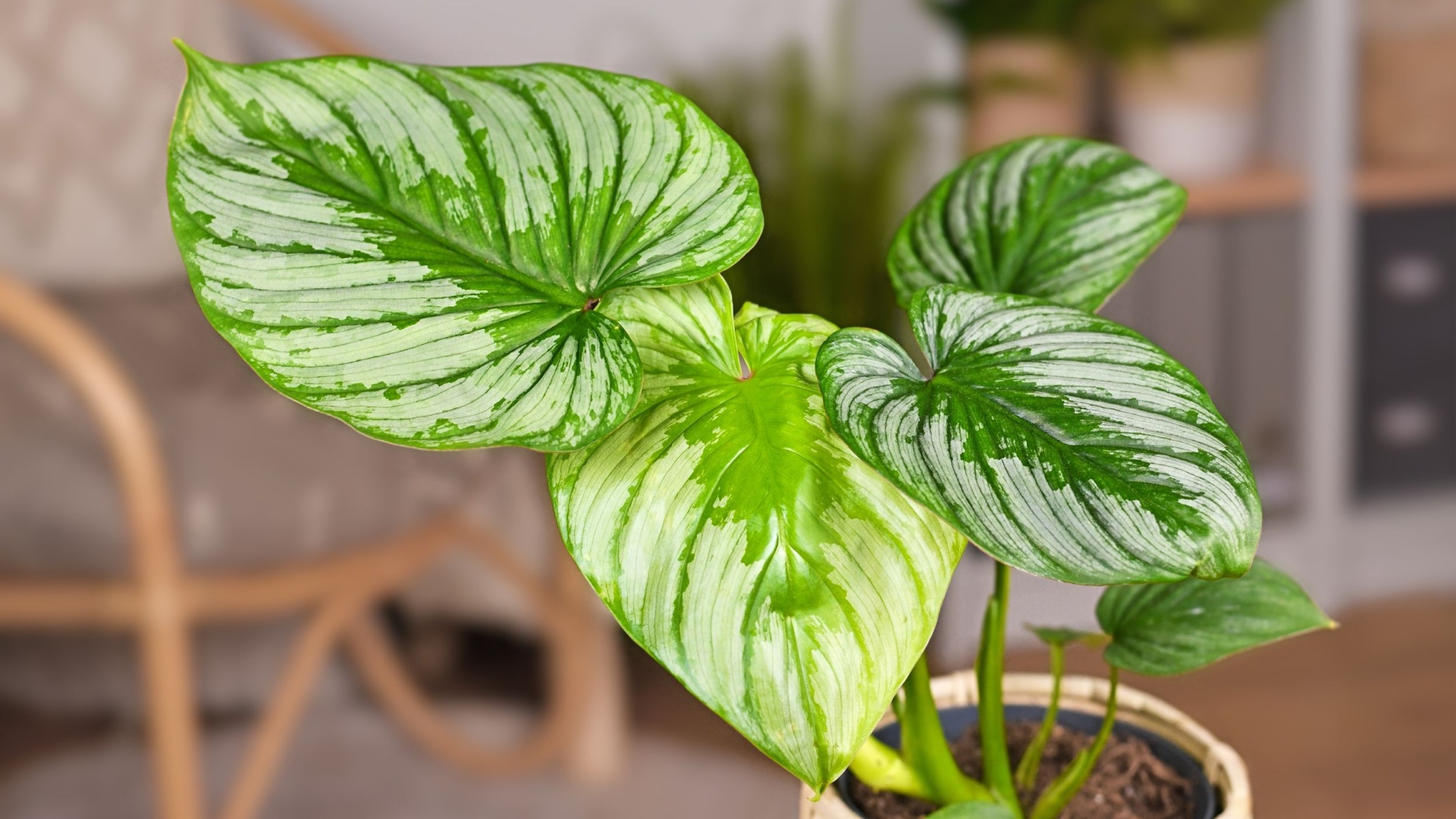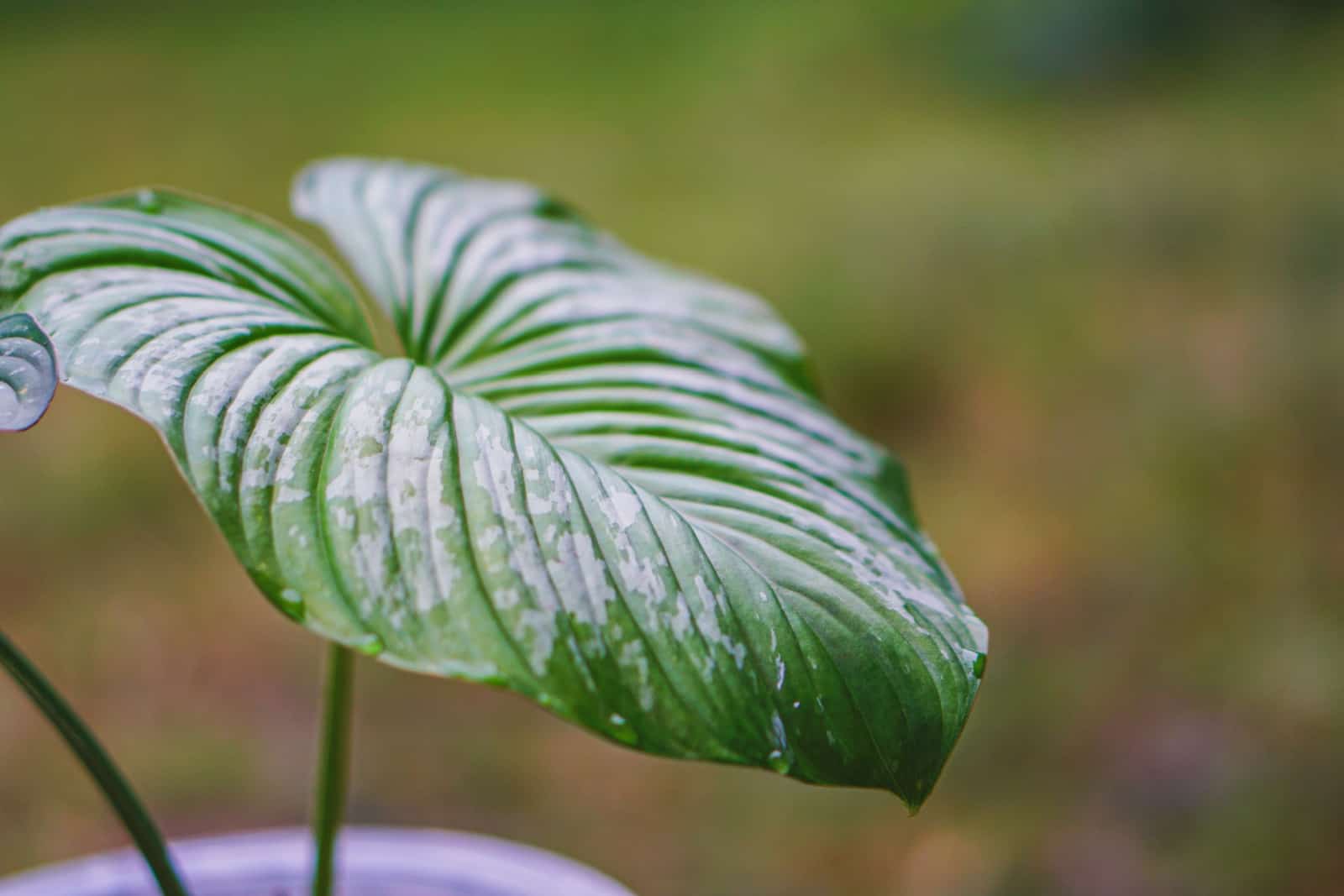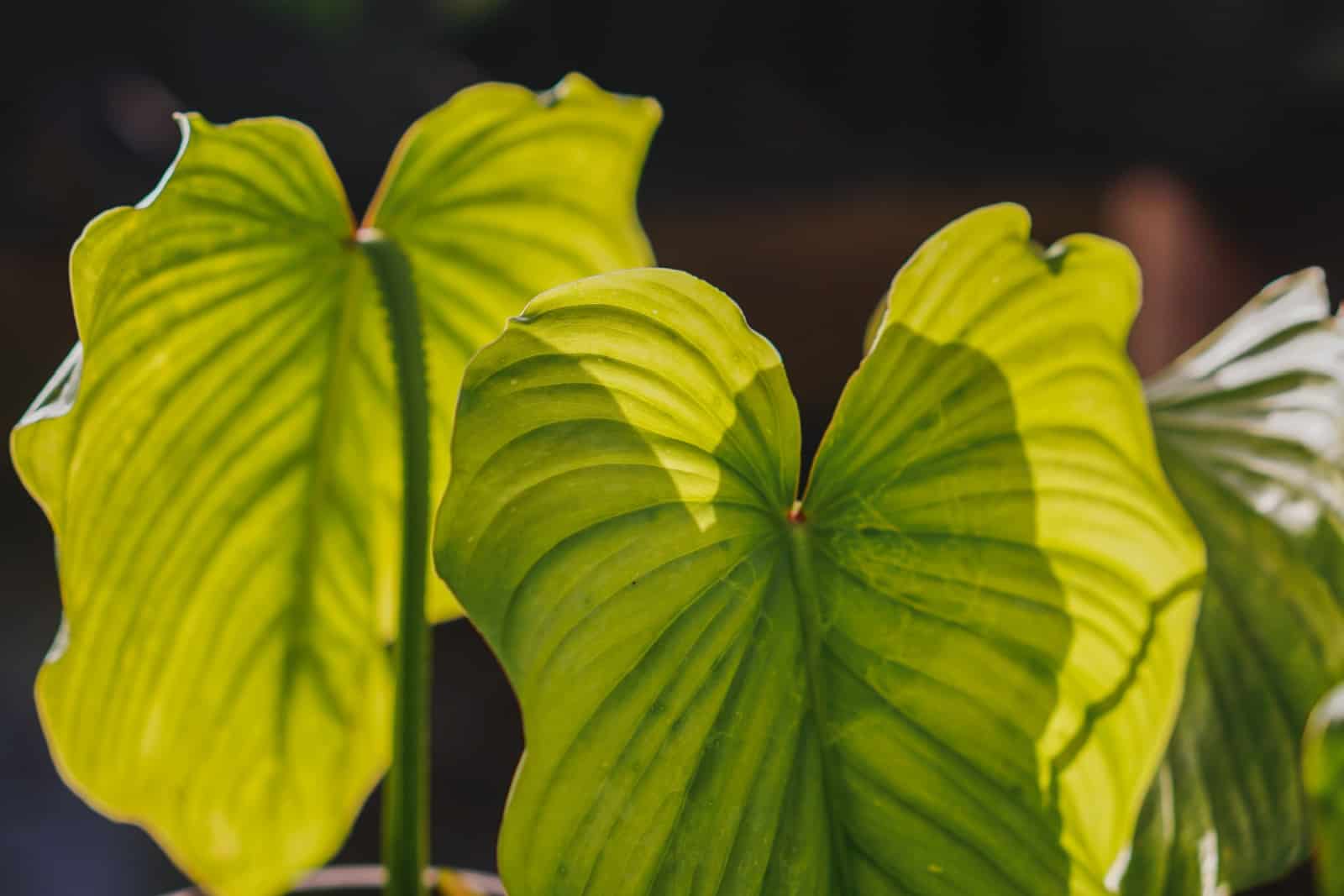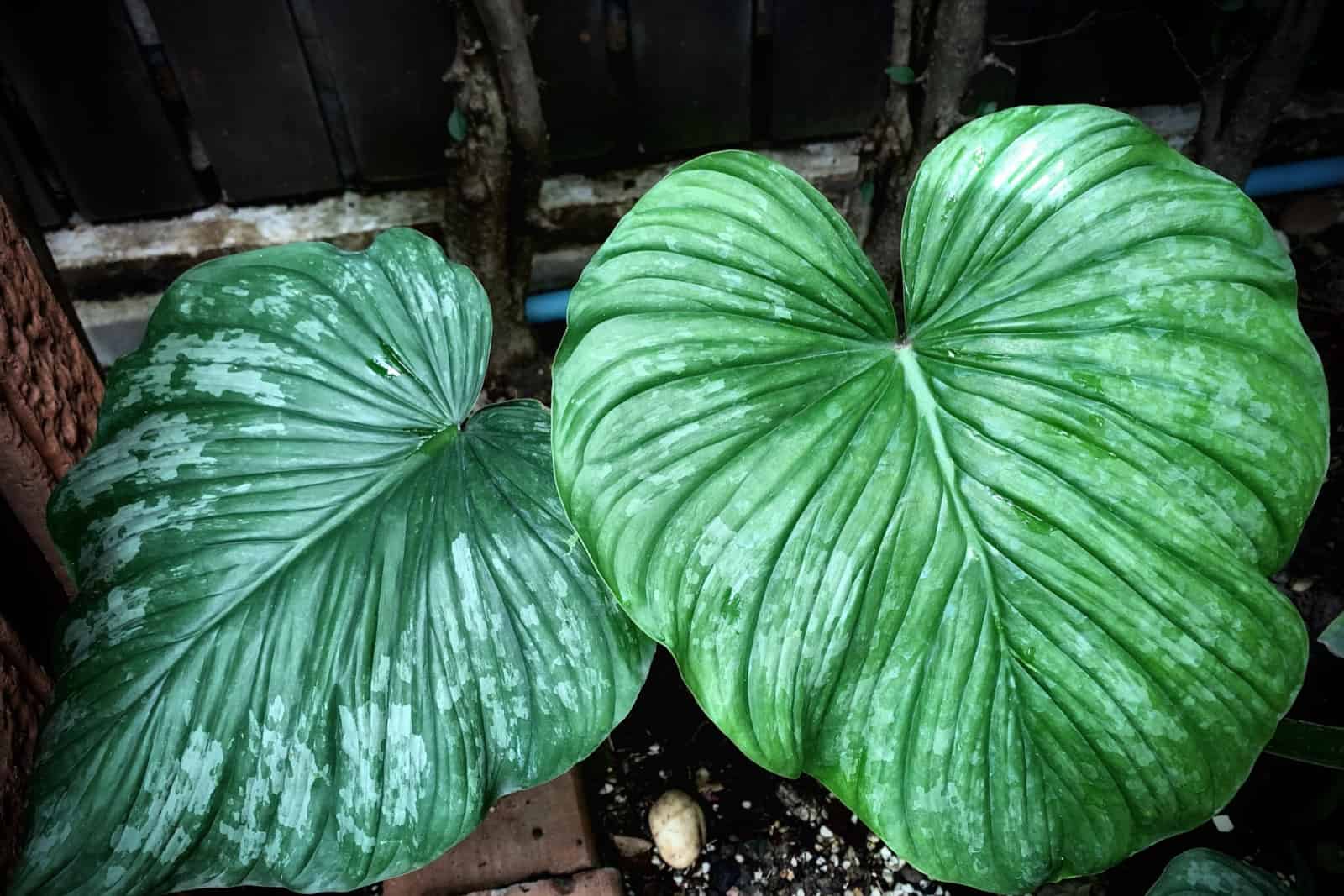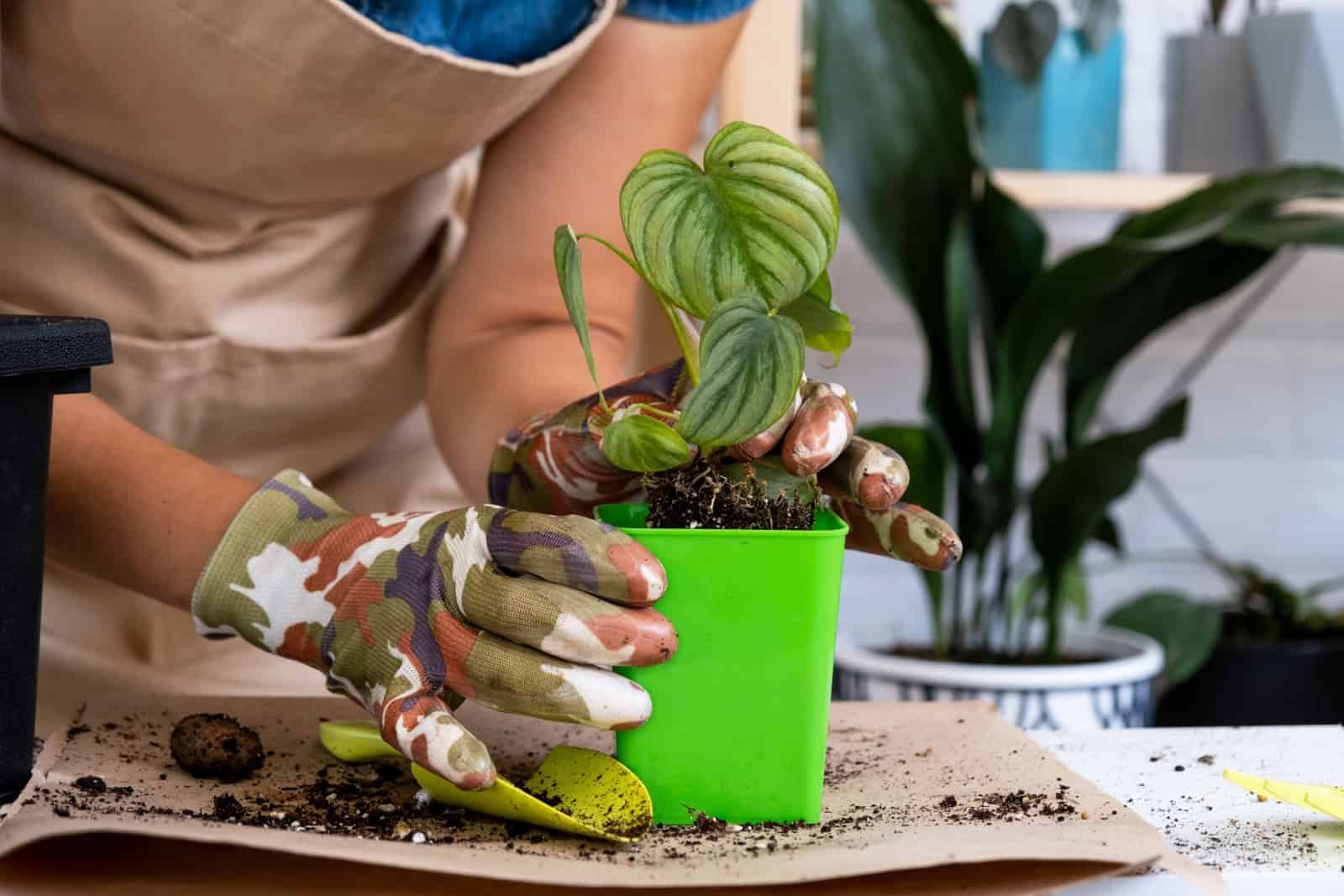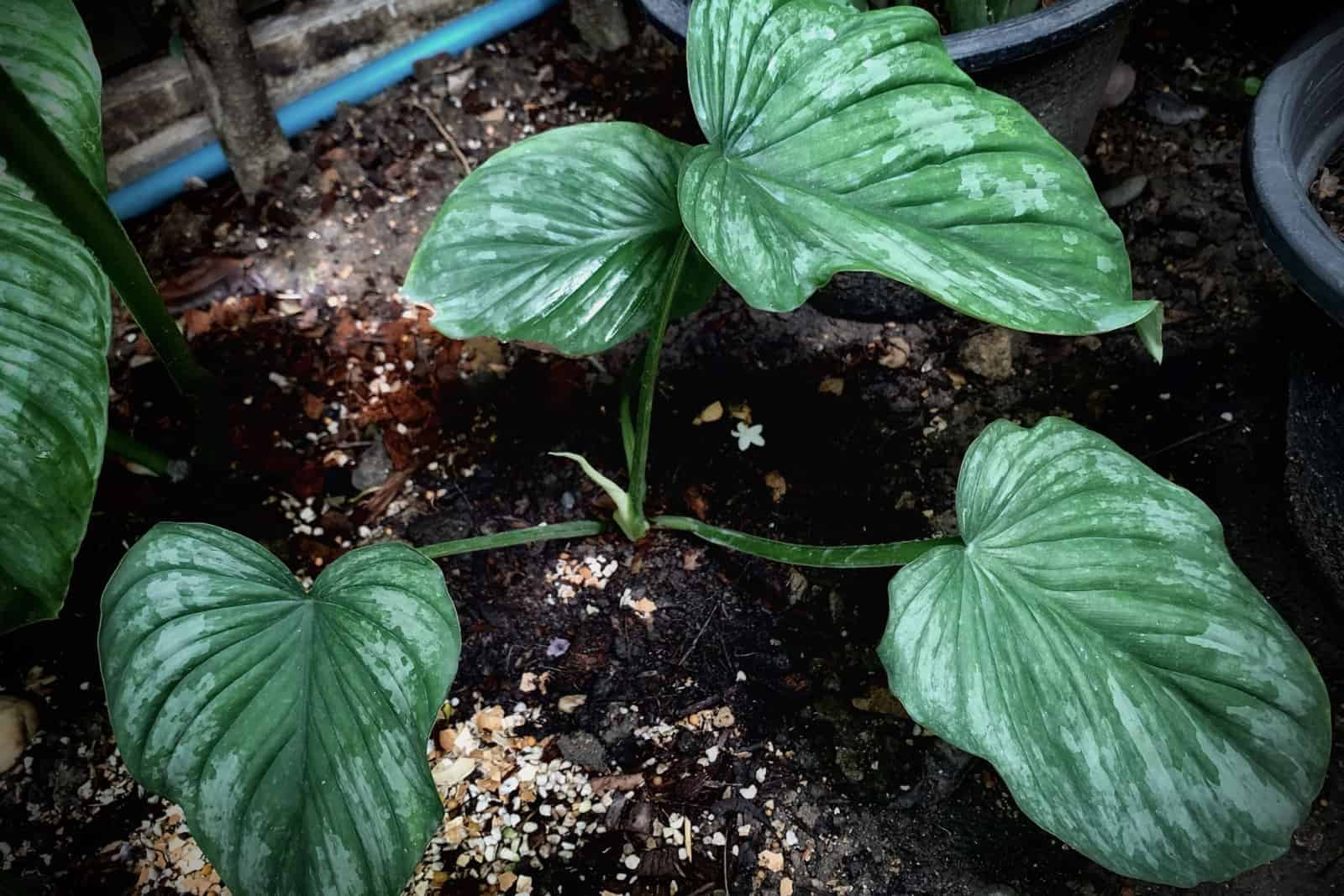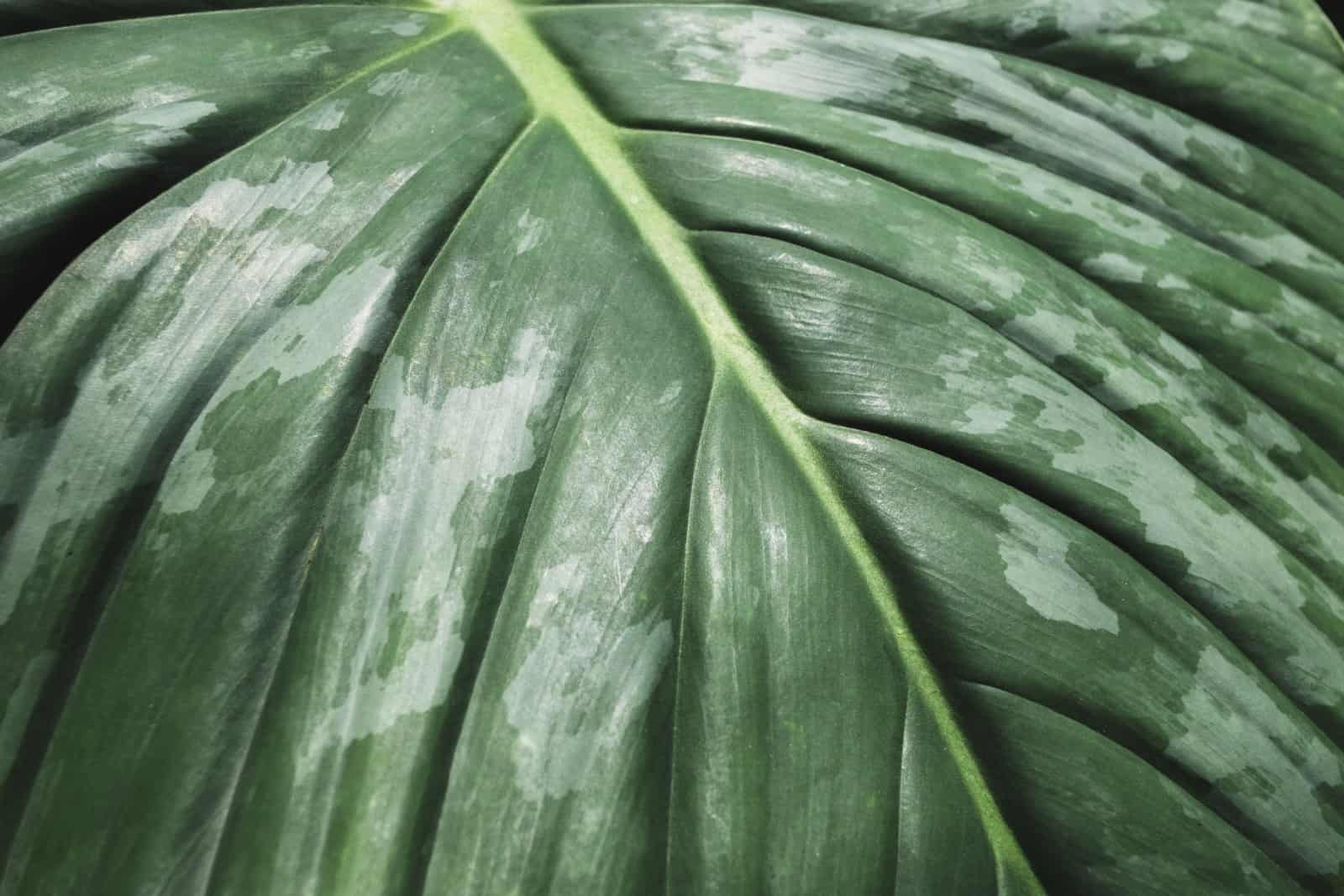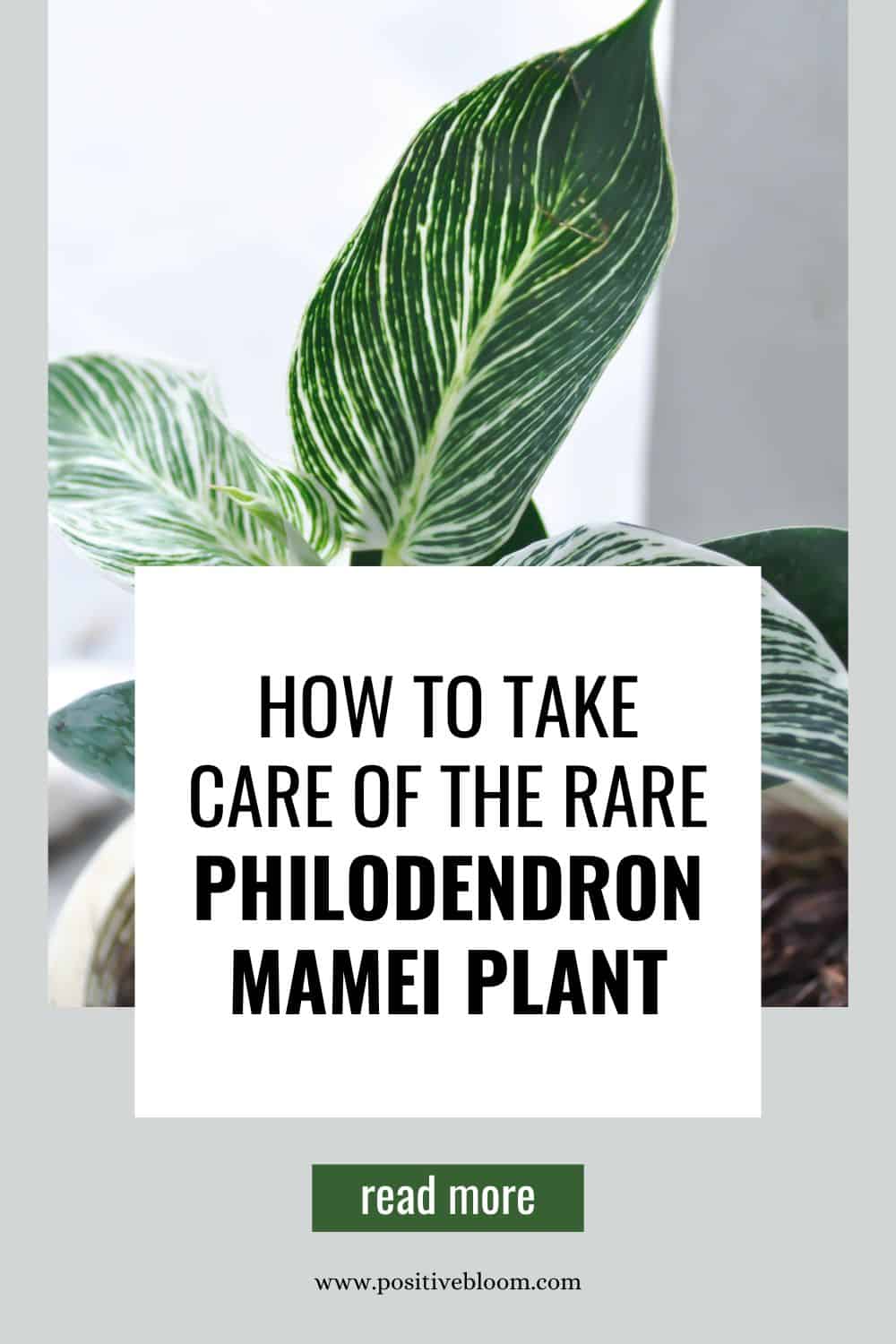If you want to expand your philodendron collection, but aren’t sure which philodendron to get, I know the struggle! With over 400 different philodendron species, choosing the right one for your home can be hard.
Luckily, I am here to help you!
Meet the lovely Philodendron mamei! Its common names are the Silver Cloud Philodendron and the Quilted Silver Leaf plant. This rare Philodendron species was discovered deep in the Ecuadorian jungles in 1883. Its broad, silvery leaves let it grow extremely quickly.
The Philodendron’s lush leaves love to climb, so you can take advantage of this trait to customize them however you like! These houseplants require the same care as any other tropical plant, so if you already have a philodendron there’s nothing to worry about.
Now, let’s learn more about this unique plant!
Philodendron Mamei Plant: Common Features
The Philodendron mamei plant is native to Ecuador and it belongs to the Araceae family, commonly known as aroids. This perennial plant has a creeping growth habit. Typically used as a ground cover, this kind of philodendron is a crawler and can also occasionally be spotted creeping up trees and walls.
You can provide this climber with something to climb on, such as a moss pole or a trellis. This plant is a slow grower, so you don’t have to worry about repotting it frequently.
The reason growers like these plants are the large heart-shaped leaves. These dark green leaves have silvery variegations all over and look absolutely magnificent!
The Mamei is known for its ruffled stem in addition to its soft and glowy leaves. These stems have red bases, which makes this rare plant even more unique.
The Mamei can reach a height of 6 feet or more with the right care. The leaves of this attractive plant can get as long as 10 to 18 inches. The Mamei also produces Red flowers, though this happens rarely.
Interestingly, there are very few differences between Philodendron mamei and Philodendron sodiroi — other than having different petioles and growth habits, these plants are almost the same and are often mistaken for one another.
After all, there are over 400 Philodendron varieties, so it is to be expected that we bump into some that look alike!
Philodendron Mamei Care Guide
The Philodendron mamei is a low-maintenance plant that thrives in USDA hardiness zones 9 to 11. It can be grown indoors perfectly fine, you just have to make sure that you provide it with the best growing conditions.
It would be ideal if you could mimic its natural habitat, which includes providing the plants with high humidity, warm temperatures, and frequent watering.
Let’s look at the plant care guide in more detail.
Soil Requirements
If you have grown Philodendron plants before, you are probably already familiar with their needs. These plants need loose, porous soil so that the air can reach their roots. The plant may become suffocated if the soil is too tightly compact.
Good drainage is another essential necessity for soil. Philodendrons thrive in a soil mix that drains properly!
Drainage is necessary to get rid of extra water and stop root rot, which is a significant problem brought on by overwatering. Prepare a pot with drainage holes and plant your Philodendron mamei in it.
This plant requires neutral soil, so the pH level should be about 7. Before planting, test it to determine what type of soil you have. Any store-bought aroid potting mix would work just fine.
You have to make sure that you provide well-draining potting soil. Therefore, you could add materials such as perlite to improve drainage or combine sphagnum moss, peat moss, vermiculite, orchid bark, coco coir, and compost to boost the nutrient content.
Light Requirements
Philodendrons are accustomed to growing in natural shade and indirect sunlight because they are native to tropical rainforests.
This indicates that your Philodendron mamei should receive bright indirect light.
If you are growing a plant inside, I suggest placing it close to an east-facing window because the morning sun is less intense and won’t burn your plant even if it is in direct sunlight.
But because afternoon direct sun is so intense and can burn your plant, you should try and keep it out of its exposure. Move it further away from the window if you keep it in a room with a south- or west-facing window so that direct sunlight won’t harm it.
A nice set of grow lights is another option if you can’t find an ideal location for your rare plant.
Water Requirements
Because the watering requirements of these plants vary depending on different factors, including temperature and humidity levels, it is challenging to establish a rigid watering regimen for them.
Fortunately, we have a few tips that will assist you in establishing the best watering routine.
In order to avoid overwatering philodendrons, it’s a good idea to make sure the topsoil is fully dry.
If the topsoil has dried out, then it is time for watering. If it still feels moist, you can postpone watering for a few days. You don’t have to necessarily use a moisture meter, you can simply use your fingers.
So, they like to have moist soil, but they can’t stand soggy soil!
This is where the drainage holes play an important role — they can get rid of any excess water that would be detrimental to the plant’s health.
Since the soil dries out more quickly in the summer, especially if you live in a hot region, you may need to water it more frequently, perhaps every other day (I usually water my Philodendron mamei twice a week).
Watering your Philodendron slowly will give the soil time to absorb the moisture, which is another helpful suggestion.
Don’t let the soil dry out completely, or your plant will suffer from underwatering. This usually leads to leaf drop and stunted growth.
Humidity Requirements
These tropical plants absolutely love humidity!
This means that finding the ideal humidity levels might be challenging, but because Philodendrons are adaptable, they can tolerate lower humidity levels while still being content. You undoubtedly want the best for your plant, so the humidity level should be approximately 70%.
The only thing that matters is that the humidity levels in your home don’t fall below 50%, so don’t panic if they don’t reach these levels.
There are some methods that you can use to improve humidity. For instance, you can invest in a humidifier. This is probably the easiest way. If you don’t want to spend money, you can always mist your plant on a daily basis.
Other methods include creating a pebble tray by putting pebbles in a tray and covering them with water. Put your plant on top of the tray, and as the water evaporates it will provide enough moisture to keep your plant growing and glowing.
You can also put your Philodendron mamei in a more humid room, such as the kitchen or bathroom, but you have to make sure that the lighting conditions are satisfactory.
Temperature Requirements
Temperature ranges between 65 and 80 degrees Fahrenheit are ideal for your Philodendron Mamei. Philos dislike abrupt temperature changes, much like Pothos plants (because they are both tropical plants).
Fortunately, maintaining their preferred temps isn’t as difficult because they are basically regular room temperatures!
To avoid being exposed to cold drafts, which could hinder your plant’s growth and development, you should keep your Philos away from windows, vents, and air conditioning. You should also keep your plant away from heat sources such as radiators or fireplaces.
Fertilizer Requirements
There are more ways to increase the nutrient content of soil to give your plant some food. As we already discussed, philodendrons prefer well-draining and nutrient-rich soil.
Your plant will receive all the crucial nutrients it requires from high-quality fertilizers, and they will also promote the growth and development of new leaves. Silvery leaves will soon sparkle in your room!
During the growing season, these plants need to receive fertilizer once a month. A nitrogen-rich fertilizer can be used to encourage the growth of lush vegetation.
It is entirely up to you whether to use a balanced granular fertilizer or a slow-release fertilizer.
If you don’t want to use fertilizer but want to increase the nutritional content of the soil, you can also add worm compost.
During the winter, your Philo will go into dormancy, which means it won’t grow or require a lot of water and nutrients. Therefore, you should refrain from fertilizing throughout the winter!
Avoid overfertilizing as well because it can result in excessive chemical and salt buildup in the soil, which interferes with pH levels and inhibits the roots of the plant from naturally absorbing water and nutrients.
Repotting
These Philodendrons only require repotting every few years, so you won’t have to worry about it.
The ideal time to repot your Philos is when they become rootbound, so you’ll know it’s time when you see those tiny roots poking out of the drainage holes!
You should repot them in a pot that is 2 inches larger than the current one, and always use fresh soil. If you put them in a pot that is too large, you increase the risk of overwatering.
Additionally, it’s crucial that the bottom of your new pot includes drainage holes because Philos love good drainage!
Pruning
These rare Philodendrons don’t require pruning to remain happy and healthy. Considering how wonderful they are, I’m sure it would be too tough to remove those lovely little leaves anyway.
However, if you detect any broken or infected leaves, remove them right away to prevent disease spread.
You can always use the healthy leaves you clip off for propagation!
Propagation
Propagating this creeper is relatively easy. There are a couple of propagation methods that you can use, but the most common one is stem cuttings. You can put these stem cuttings in either water or soil.
Here’s how you do it:
Stem Cutting In Water
Prepare a healthy Philodendron, a sharp pair of shears that have been cleaned and disinfected (use bleach or rubbing alcohol), and a container or clear vase for water propagation.
The steps for water propagation are as follows:
1. Find a cutting that has at least one node attached to it. Use sterilized shears to cut it.
2. Place the cutting in lukewarm, filtered water in a jar or vase. Pay attention to the nodes because at least one of them ought to be submerged.
3. Place the Philodendron cutting in bright indirect light.
4. To keep the cutting from rotting, replace the water in the jar every two to three days.
5. It normally takes a few weeks for new growth to develop. Once the roots have developed, it is time to put your baby plant in the soil.
Stem Cutting In Soil
Prepare fresh potting soil, a good set of pruners, and a rooting hormone in case you decide to plant the stem cuttings in the soil. These are the steps:
1. Cut the plants into cuttings in the same manner as for water propagation.
2. Add potting soil to the container. Peat moss, perlite, orchid bark, and worm castings should all be combined.
3. Make a hole in the middle of the soil that is big enough to accommodate the Philodendron cutting.
4. Insert the cutting into the hole and, if necessary, add soil.
5. Put the container in a warm location with bright indirect light.
6. Make sure that all the conditions are ideal because the roots will start to show after a few weeks.
Philodendron Mamei Common Issues
Even though the Philodendron mamei is a low-maintenance plant that’s also relatively hardy, it is still susceptible to certain issues, such as pest infestation. However, it is also not a fan of inadequate plant care like overwatering or underwatering, overfertilization, sudden temperature changes, direct sun, or low humidity.
Let’s find out more!
Philodendron Mamei Toxicity
Unfortunately, this lovely Philodendron is toxic to both pets and humans. It contains calcium oxalate crystals that make it toxic.
If ingested, it can cause vomiting, nausea, diarrhea, and gastrointestinal issues. You should immediately go to the doctor or a vet if this happens.
This is why it is important to keep these plants out of reach.
Pest Infestation
If you have a lot of indoor plants, you probably have already experienced a pest infestation because they are not uncommon. Pests are not deadly in small numbers, but if they establish a colony, you’re in big trouble.
If you identify any pest species early enough, you can easily get rid of them and stop them from harming your beautiful philodendron.
It will take a long time to get rid of all the pests if the infestation gets bad.
Your Philodendron’s huge leaves are likely to have aphids, mealybugs, fungus gnats, thrips, and spider mites at any given time.
Here are several traits that can help you identify each bug.
Aphids — these little pests are usually found on the undersides of leaves. They frequently cluster in huge groups, mostly harm new growth, and consume plant juices, which weakens the plant.
Scales — scales are sap-sucking pests that cling to the leaves, twigs, branches, and fruits of their host plants. They are such strangely formed, stationary pests that they frequently resemble bumps instead of insects.
Spider mites — insects with soft bodies that deposit silky webbing on the leaves. They can also be found on the undersides of leaves.
Fungus gnats — tiny files occasionally seen around houseplants. They affect organic materials, potting soil, and other areas where organic matter breaks down. They can be problematic for indoor plants, nurseries, and greenhouses because their larvae eat roots. Drains, soggy soil, sick plants, and organic soil waste all attract these little annoyances.
Mealybugs — these bugs spread quickly, have a cotton-like covering, and like moist surroundings.
How To Get Rid OF Pests
Mealybugs can be effectively treated using insecticides and insecticidal soaps.
To eliminate scales, plants are frequently sprayed with water. An application of insecticidal soap is required if the infestation is severe or the insects come again.
The most often used remedies for treating spider mite infestations include neem oil, rubbing alcohol, hydrogen peroxide, and insecticidal soap. Spider mites can be removed by brushing the leaves with a solution of rubbing alcohol and water after dipping a towel in it.
Aphid infestations can be managed in a manner similar to how spider mites are dealt with: using insecticides, neem oil, or physical removal (but they are super tiny so this could be hard).
There are a few different ways to get rid of plant flies. For instance, pebbles added to the soil’s surface or introducing plant fly predators are all good fly traps. The best techniques to prevent a plant fly infestation include keeping your surroundings tidy and being careful not to overwater or overfertilize your plant.
Remember to carefully follow the instructions provided in the care guide for these plants because a healthy plant won’t be vulnerable to pest infestations!
Plant Diseases
Luckily, this Philo is not susceptible to many plant diseases. Root rot is the most prevalent disease, though leaf spot occurs if nearby plants are affected.
If your plant is overwatered, it will often result in root rot. Leaves turning yellow, and smelly and soggy soil are the first signs of root rot. You should repot the plant as soon as possible in this case.
When repotting, trim off any damaged or decaying roots. Use new potting soil that is not contaminated.
Brown Leaves
It is always a shame to see once-glowing leaves looking completely brown and crispy. Here are some potential reasons for brown leaves:
• Watering problems: Your Philodendron may develop dark leaves if it isn’t given enough water. Brown spots could indicate that you have overwatered your plant.
• Temperature stress: Your beautiful plant may experience temperature stress and show browning if the temperature is more than 90 degrees Fahrenheit or the leaves have been exposed to direct sunlight for too long.
• Fertilizer burns: If you fertilize your Philodendron too much or you use the wrong fertilizer, the leaves will burn.
Yellow Leaves
Here is a list of potential reasons leaves might turn yellow:
• Overwatering: Yellow leaves mainly appear in cases of excessive soil saturation, which usually indicates root rot.
• Bright light or direct sunlight: If the big leaves start to turn yellow, always check the light levels.
• Underwatering: Your plant will show yellowing if it is dehydrated.
• Low humidity: When the humidity is too low, the soil holds too much water, which leads to the growth of fungus, root rot, and yellowing of the leaves.
Frequently Asked Questions
1. Is the Philodendron Mamei rare plant?
Yes, the Philodendron mamei is considered to be a rare philo species that is not commonly seen in households. However, recently it has become much more popular due to its easy propagation and low-maintenance requirements.
2. What is the most beautiful Philodendron?
Though all philodendrons are lovely, some certainly stand out. The Philodendron Plowmanii is one of the Philodendron genus’ most exquisite species. It has broad, variegated-green leaves, some of which have silvery streaks when the plant is young. As the plant matures, the undersides of the leaves turn grayish.
The Philodendron Prince of Orange is one of the most stunning plants if you prefer those with more vibrant colours. Yellow is the initial color of fresh growth, which then changes to reddish-brown tones and darker hues of green.
To Sum Up
The Philodendron mamei is a rare philodendron species that produces lovely deep green leaves covered with silvery variegations. Its shimmery leaves are quite unique and exquisite!
Even though it is a rare Philodendron, this doesn’t mean that it needs any special plant care. In fact, they have almost the same requirements as any other Philo.
Make sure that they receive bright indirect sunlight, enough water to keep their soil moist, and high humidity to keep them glowing. They also need well-draining soil, some nutrients, and warm temperatures.
If you are lucky enough to find the Mamei species, nurture it so that you can propagate the plant and grow a new one. You can either sell it or gift it to a friend.
I hope this article was helpful.
Until next time!
Like this post? Share or pin it for later!

